 Last additions Last additions |
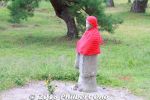
Jizo statue on Amanohashidate.Nov 27, 2018
|
|

Emperor Showa's Amanohashidate poem.Nov 27, 2018
|
|
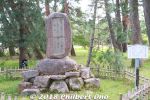
Monument for Emperor Showa's Amanohashidate poem he wrote when he visited this area in 1951.Nov 27, 2018
|
|
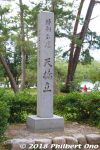
Amanohashidate marker.Nov 27, 2018
|
|

How Amanohashidate sandbar formed. Sand from the east coast of Tango Peninsula carried by ocean currents were repeled by the river current of the Noda River. The sand thereby accumulated from the northern end to enclose the bay.Underwater, Amanohashidate looks like a sand wall.Nov 27, 2018
|
|
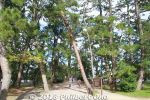
Entrance to Amanohashidate's path to the other end. Japanese pine trees all over on both sides of the road.Nov 27, 2018
|
|

Sightseeing map of Amanohashidate.Nov 27, 2018
|
|
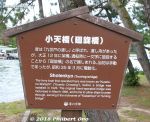
About the rotating bridge (Shotenkyo).Nov 27, 2018
|
|
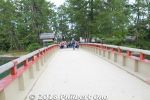
Rotating bridge for Amanohashidate.Nov 27, 2018
|
|
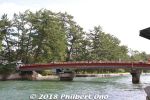
Rotating bridge for pedestrians again.Nov 27, 2018
|
|
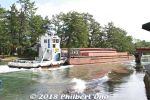
Most of the boats carry freight.Nov 27, 2018
|
|
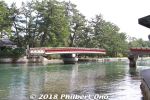
On the southern end, this bridge to Amanohashidate rotates quite often to allow boats to pass. Nov 27, 2018
|
|
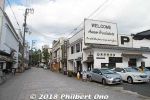
Near the entrance to Amanohashidate, this welcome sign with "One of the three famous beauty spots of Japan" has been here for decades.According to Japanese Wikipedia, the "Nihon Sankei" (Japan's Scenic Trio) label originated in 1643 by Hayashi Gaho (aka Hayashi Shunsai), a Japanese Neo-Confucian scholar who wrote a book mentioning these three sights. The expression "Nihon Sankei" was later coined in 1689 by another Japanese Neo-Confucianist scholar, Kaibara Ekken in his travel diary. So "Nihon Sankei" goes way back to the 17th century.
It's really amazing that it has stuck throughout these centuries even with Mt. Fuji not included. With Japan having so many places of beauty, it would be nearly impossible today for anyone to unilaterally declare any three sights as the "Best Three."
To the question of why it's always the best "three," the answer seems to be more complicated. It seems the Japanese have had numerical favorites for many centuries. Many odd numbers are favorites including one, three, five, and seven. This might sound familiar when you think about haiku and tanka poetry syllables, and the 7-5-3 coming of age celebration for kids. But the number "three" for "Best Three" has also stuck for centuries and still today.Nov 27, 2018
|
|
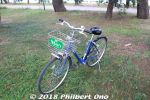
My rental bicycle. Rental bicycles also available at the entrance to the Amanohashidate sandbar.Nov 27, 2018
|
|

What to see from Amanohashidate Station. Best to rent a bicycle at the souvenir shop in front of the station.Nov 27, 2018
|
|
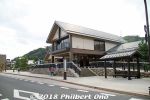
Amanohashidate Station (Kyoto Tango Railway, nicknamed "Tantetsu" or "Willer Trains") is close to Amanohashidate sandbar. Trains from JR Osaka, Kyoto, and Fukuchiyama Stations stop here.Nov 27, 2018
|
|
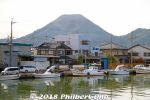
Nov 27, 2018
|
|
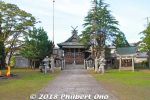
Next to the bridge is this local Shinto shrine named Minazuki Jinja dedicated to Tsukuyomi (月夜見命), the Moon deity and younger brother of Sun Goddess Amaterasu. 水無月神社Nov 27, 2018
|
|
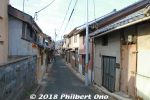
This is the road behind the homes along the inlet.Nov 27, 2018
|
|
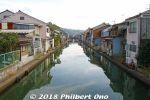
Beyond the bridge, the inlet has no boats.Nov 27, 2018
|
|
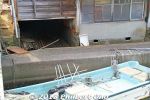
Nov 27, 2018
|
|
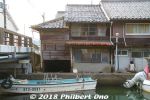
Here's one house that used to have a boat garage connected to the water.Nov 27, 2018
|
|
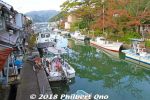
Nov 27, 2018
|
|
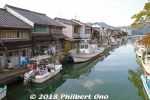
Nov 27, 2018
|
|
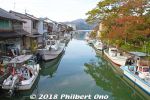
Get some good shots of the inlet from the bridge.Nov 27, 2018
|
|
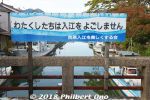
Walk until this bridge going over the inlet. Banner says, "We won't pollute the inlet."Nov 27, 2018
|
|
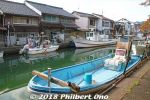
Yoshihara Inlet Nov 27, 2018
|
|
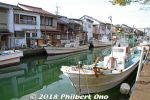
Nov 27, 2018
|
|
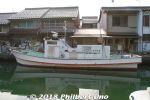
Nov 27, 2018
|
|
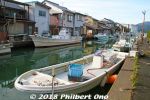
Nov 27, 2018
|
|
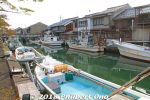
Nov 27, 2018
|
|
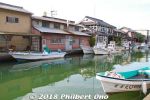
Nov 27, 2018
|
|
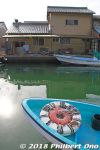
Nov 27, 2018
|
|
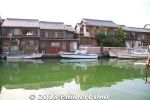
You can just walk along the inlet (be careful not to trip over the boat lines and ropes).Nov 27, 2018
|
|
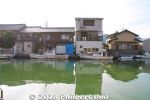
The homes used to have built-in boat garages like at Ine, but they were abolished and the boats are moored right in front instead. Nov 27, 2018
|
|
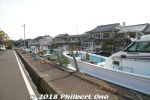
Yoshihara Inlet is a picturesque waterfront fishing neighborhood with boats moored right outside. Fishing village since the Edo Period. Located on the north end of Isazu River (伊佐津川). "Yoshihara" means reed fields, so this area used to have reed beds on marshy land. About 20-min. walk from JR Nishi-Maizuru Station (JR Maizuru Line). Map hereNov 27, 2018
|
|
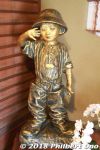
Nov 27, 2018
|
|
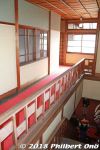
Nov 27, 2018
|
|
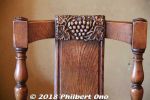
Seat back.Nov 27, 2018
|
|
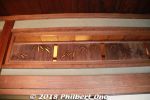
Nov 27, 2018
|
|
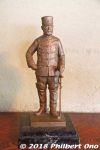
Small statue of Admiral Heihachiro Togo in a private dining room.Nov 27, 2018
|
|
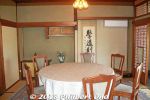
Private dining room at Shoeikan.Nov 27, 2018
|
|
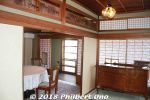
Private dining room.Nov 27, 2018
|
|
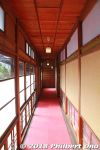
Nov 27, 2018
|
|
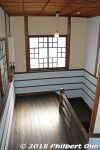
Stairway.Nov 27, 2018
|
|
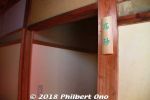
Private dining room named "Takasago."Nov 27, 2018
|
|
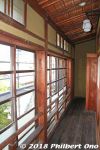
Nov 27, 2018
|
|
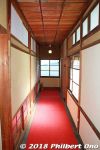
Nov 27, 2018
|
|
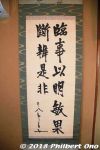
Nov 27, 2018
|
|
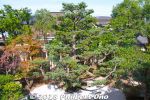
Nov 27, 2018
|
|
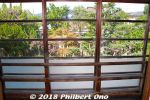
Garden view from a private dining room.Nov 27, 2018
|
|
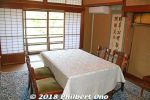
Private dining room.Nov 27, 2018
|
|
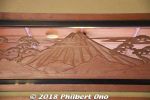
The private dining rooms are quite ornate with carved transoms like this one of Mt. Fuji.Nov 27, 2018
|
|
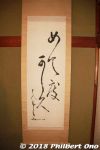
Calligraphy by legendary Admiral Heihachiro Togo.Nov 27, 2018
|
|
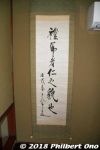
The 2nd floor's private dining rooms are adorned with calligraphy by legendary Admiral Heihachiro Togo.Nov 27, 2018
|
|
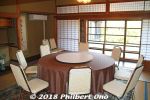
Private dining room.Nov 27, 2018
|
|
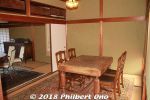
Private dining room.Nov 27, 2018
|
|
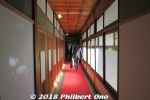
We could also go upstairs and tour the private dining rooms.Nov 27, 2018
|
|
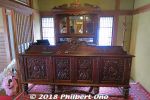
Nov 27, 2018
|
|
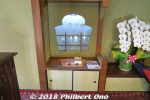
Nov 27, 2018
|
|
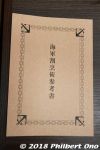
For the restaurant menu and recipes, the restaurant chefs use an old navy recipe book that was used by navy galley staff in the Imperial Japanese Navy. It has about 200 recipes for Western dishes and confections.Nov 27, 2018
|
|
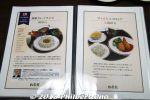
The restaurant's menu is quite cheap, prices ranging from ¥900 for Navy curry rice to ¥4,500 for a full course.Nov 27, 2018
|
|
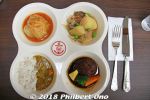
We had a special sample of the curry rice, cabbage roll, stewed hamburger, and potatoes and meat (niku-jaga). Curry rice is famous as a navy dish in Japan.Shoeikan restaurant, Maizuru, Kyoto Prefecture.Nov 27, 2018
|
|
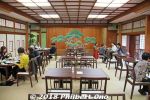
The 1st floor is the main dining room. It even has a Noh stage.Nov 27, 2018
|
|
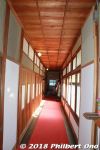
Shoeikan corridor to the restaurant.Nov 27, 2018
|
|
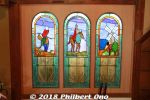
Entrance hall stained glass.Nov 27, 2018
|
|
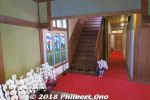
Shoeikan entrance hall.Nov 27, 2018
|
|
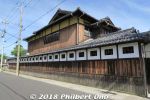
The ryokan's annex building was left unused and decrepit for many years and was on the verge of being torn down until a citizens group got together to clean, renovate, and preserve the building. They finally decided to make it a Western-style restaurant serving navy cuisine. It just opened on Oct. 11, 2018. Glad that they preserved the building.Nov 27, 2018
|
|
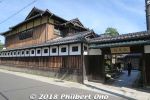
Shoeikan was originally the annex (別館) of the Shoeikan ryokan inn opened in 1904 (Meiji 37). The inn was built for navy VIPs like Admiral Heihachiro Togo who led the Japanese navy during the Russo-Japanese War.Hours
Lunch: 11:30–14:30 Dinner: 17:30–21:30
About 1 km from JR Higashi Maizuru Station. Parking available.
Map: https://goo.gl/maps/sQd8ZdekJqA2Nov 27, 2018
|
|
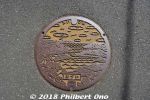
Maizuru manhole shows Maizuru Bay in northern Kyoto Prefecture.Nov 27, 2018
|
|
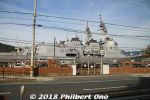
This is the Atago, a guided missile destroyer.Nov 27, 2018
|
|
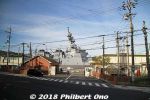
Japan Maritime Self-Defense Force's Maizuru navy base (舞鶴基地) where the Hyuga helicopter carrier, Aegis ship, and other navy ships are based.This base is in charge of maritime security along the Sea of Japan's coast from Yamaguchi to Aomori Prefectures.Nov 27, 2018
|
|

Nov 27, 2018
|
|
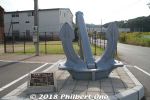
Old anchor for the Shirane destroyer that was retired in 2015.https://en.wikipedia.org/wiki/JDS_ShiraneNov 27, 2018
|
|
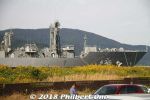
Maizuru Brick Park is right next to the Japan Maritime Self-Defense Force's Maizuru navy base.Nov 27, 2018
|
|
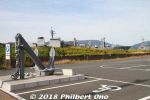
Nov 27, 2018
|
|
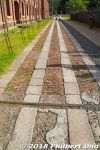
Nov 27, 2018
|
|
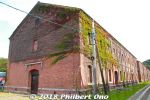
Nov 27, 2018
|
|
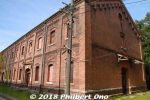
Nov 27, 2018
|
|
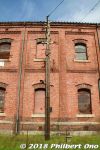
The brick park has been used as a backdrop in Japanese movies. Nov 27, 2018
|
|

Nov 27, 2018
|
|

Nov 27, 2018
|
|
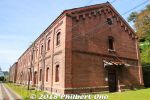
Nov 27, 2018
|
|
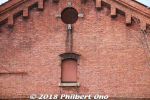
Nov 27, 2018
|
|
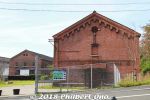
This part of the park had buildings owned by the Japanese government. Not open to the public.Nov 27, 2018
|
|
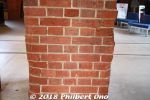
Nov 27, 2018
|
|
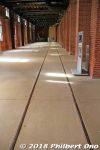
Brick Building No. 5 had rails.Nov 27, 2018
|
|

Inside Brick Building No. 5 (赤れんが5号棟), the park's largest building. Built in 1918 to store torpedoes, depth charges, and mines. After the war, it was used by a warehouse company.Now used as an event hall and cafe space (cafe open only on weekends). It can be rented to hold exhibitions or events (concerts, weddings, etc.). It has been reinforced with these steel girders for earthquake resistance. National Important Cultural Property.Nov 27, 2018
|
|

Nov 27, 2018
|
|
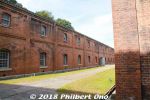
Nov 27, 2018
|
|
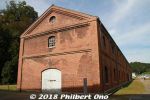
Nov 27, 2018
|
|

Nov 27, 2018
|
|

Nov 27, 2018
|
|
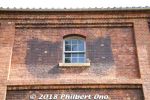
During World War II, the brick buildings were painted black to make them less noticeable. The black paint still remains here and there. Amazing that these buildings have survived. Maizuru's weapons factories and navy base got heavily bombed by American planes in July 1945, but not this arsenal.Nov 27, 2018
|
|
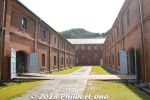
Nov 27, 2018
|
|
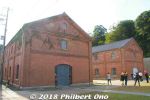
These brick buildings are not open to the public.Maizuru Brick Park, Kyoto Prefecture.Nov 27, 2018
|
|
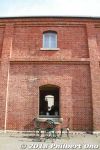
Nov 27, 2018
|
|
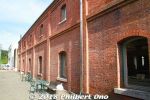
Nov 27, 2018
|
|

Ancient dugout canoe found in Maizuru.Nov 27, 2018
|
|
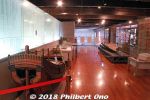
Maizuru World Brick Museum on the upper floor. Exhibits local historical artifacts. There's no English though.Nov 27, 2018
|
|
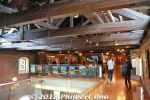
The museum is on the upper level.Nov 27, 2018
|
|
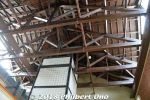
Ceiling of the huge Maizuru World Brick Museum.Nov 27, 2018
|
|
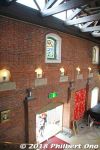
Very high brick wall.Nov 27, 2018
|
|
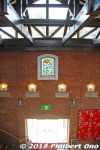
Inside the huge Maizuru World Brick Museum.Nov 27, 2018
|
|
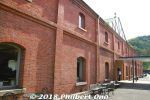
Opened in 2012, Maizuru Brick Park is a complex of 12 large brick buildings near the Japanese navy base. They were built from 1901 until the 1920s to store munitions (arsenal) for the Imperial Japanese Navy. Eight of the buildings are National Important Cultural Properties and a few of them have been renovated and opened to the public. This is the first building you enter, the Maizuru World Brick Museum (赤れんが博物館).
Hours 9:00 am–5:00 pm, closed Dec. 29–Jan. 1. 15-min. walk from JR Higashi-Maizuru Station (JR Maizuru Line and Obama Line). Parking available.
Map: https://goo.gl/maps/ZuFd1eXrNdsNov 27, 2018
|
|

How to promote crab.Nov 27, 2018
|
|
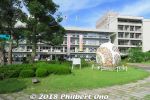
Maizuru City Hall is next to Maizuru Brick Park.Nov 27, 2018
|
|
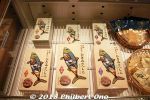
Heshiko for sale.Nov 27, 2018
|
|
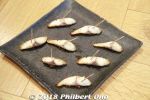
A local fish delicacy called "heshiko." Heshiko is made in this coastal region of Kyoto and Fukui Prefectures. It uses mackerel (saba), sardines (iwashi), or Pacific saury (sanma) that are salted and then fermented in rice bran (nuka). For heshiko, mackerel is most popular and the process takes two years. It is a traditional way to preserve fish for later consumption without refrigeration. It was a common (and cheap) food for the masses, but now it's a delicacy.
This restaurant believes too much salt is not so healthy, so they take only two weeks to salt and ferment the fish. This method is called asazuke (浅漬け) which means "lightly pickled." We sampled the mackerel prepared this way (and grilled), but I thought it was very salty already and hardly any taste of fermentation.Nov 27, 2018
|
|
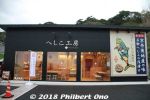
Tasted more local food here at Heshiko Kobo Hisami (へしこ工房 Hisami), a restaurant/shop in Kyotango.Map: https://goo.gl/maps/Jq7NoojH59s
http://www.hisami-kasade.com/page/shop.php#heshikoNov 27, 2018
|
|
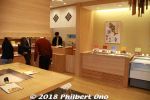
Inside Heshiko Kobo Hisami.Nov 27, 2018
|
|
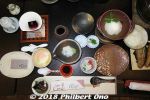
BreakfastShorenkan Yoshinoya Map: https://goo.gl/maps/hAHehEVDsft
http://taiza.jp/en/Nov 27, 2018
|
|
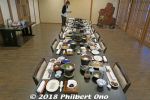
Breakfast.Nov 27, 2018
|
|
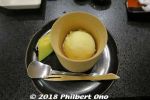
Yuzu sherbet. Yummy!Nov 27, 2018
|
|
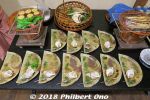
Nov 27, 2018
|
|
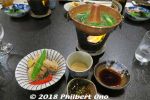
Shorenkan Yoshinoya ryokan is probably more famous for its food, especially crab during crab season (Nov. to March). But it wasn't crab season when we were there so we didn't have any crab. But the food was still excellent. Kyotango, Kyoto Prefecture.Nov 27, 2018
|
|
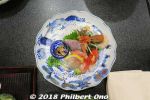
Nov 27, 2018
|
|
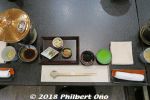
Dinner started with this.Nov 27, 2018
|
|

Dining room.Nov 27, 2018
|
|
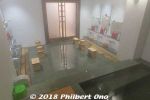
Indoor bathing area.Nov 27, 2018
|
|
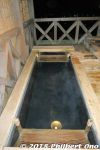
Nov 27, 2018
|
|
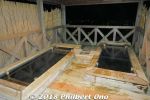
Outdoor baths on the balcony. It was night so I couldn't see the scenery. But it was great that we could try these two different baths during our overnight stay.Nov 27, 2018
|
|
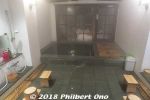
This is the other bath named “Vidro-no-Yu” (ビードロの湯) and also designed by Alexander Wilds and his artist wife Yukiko Oka. The indoor part. The glass windows were a design highlight (hard to see because of the steam and dark night). The glass door opens to a balcony with a bath.Nov 27, 2018
|
|
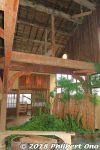
Facing the bath's garden area.Nov 27, 2018
|
|
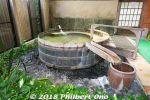
Since the ryokan celebrates the Showa Period (implied by the name "Shorenkan"), he aimed to make the bath have a Showa/Taisho Period feel. It was a tough job because they had to haul everything in and out manually. No accessible road so they had to roll the wooden barrel tub to the building manually (it couldn’t be rectangular). This bath was built during June to Oct. 2003.Nov 27, 2018
|
|
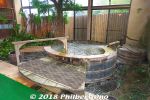
The bath in a wooden barrel. They allowed men and women to use this bath on alternate days.http://alexanderwilds-japan.blogspot.com/2017/12/alexander-wilds-architecture-yoshinoya.htmlNov 27, 2018
|
|
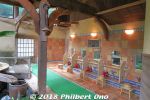
For Shoren-no-Yu, Alexander Wilds and his artist wife Yukiko Oka designed and built most everything including the garden. The shelves in the dressing room were made by his friend. Stained glass was made by his mother. Ceramic tiles are Mexican, leftover from a previous project of his. The bathhouse was originally an abandoned house which he stripped.Nov 27, 2018
|
|
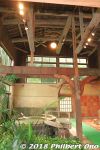
The "Shoren-no-Yu" (昭恋の湯) bath was originally an abandoned building that was renovated into a bath with a high ceiling and garden. Most everything was designed by Alexander Wilds and his artist wife Yukiko Oka. Wilds is an American sculptor from New Orleans living in Japan since 1985. He currently teaches art at Yamanashi Gakuin University in Kofu, Yamanashi Prefecture.Nov 27, 2018
|
|
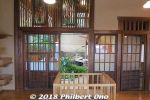
Entrance to the bath area.Nov 27, 2018
|
|
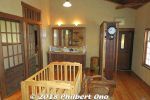
Dressing room.Nov 27, 2018
|
|
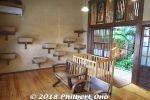
This is the dressing room for the bath named "Shoren-no-Yu" (昭恋の湯). (“Shoren” means “Love of the Showa Period.” And “Yu” means hot spring water.)The ryokan had two hot spring baths, and both were designed by an American. Nov 27, 2018
|
|
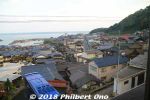
View from my room.Nov 27, 2018
|
|
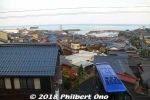
View from my room.Nov 27, 2018
|
|
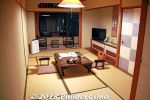
Nice Japanese-style room.Nov 27, 2018
|
|
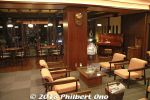
LobbyNov 27, 2018
|
|
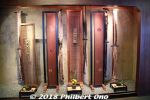
Lobby entrance.Nov 27, 2018
|
|
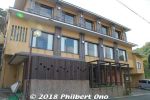
This is Shorenkan Yoshinoya (昭恋館よ志のや), a hot spring ryokan on the Tango Peninsula (Kyotango). Founded in 1928, it has 11 guest rooms.Nov 27, 2018
|
|
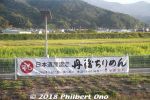
Banner commemmorating the 300th anniversary of Tango chirimen in 2018.Nov 27, 2018
|
|
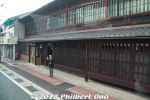
He even waved goodbye to us!Nov 27, 2018
|
|
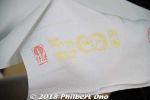
Seal of approval on chirimen fabric. Although Yoshimura Shouten is mainly a wholesaler, they also sell fabrics to individuals.http://yoshimura-shouten.jp/Nov 27, 2018
|
|

Seal of approval on chirimen fabric.
Nov 27, 2018
|
|

Chirimen fabric inspector uses a light box to carefully check for any defects and flaws in the material. Any defects in the material will reduce its value and the fabric (or kimono) will be sold for less.Nov 27, 2018
|
|
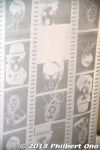
Yoshimura Shouten also creates its own designs like this "Hollywood chirimen" prototype with the the likeness of Audrey Hepburn, Charlie Chaplin, and Marilyn Monroe.Nov 27, 2018
|
|
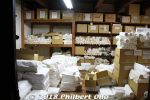
Inside their kura storehouse.Nov 27, 2018
|
|
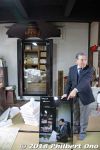
Mineyama Branch Manager Yoshioka Hitoshi shows a PR poster of Bando Tamasaburo V posing with a Tango chirimen fabric in front of the shop's kura storehouse near where Yoshioka is standing.Tamasaburo V is one of the most famous and popular kabuki actors in Japan and Living National Treasure. He loves Tango chirimen fabrics and kabuki costumes also use Tango chirimen.Nov 27, 2018
|
|
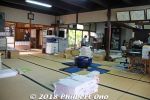
Inside Yoshimura Shouten. They have a small office space on the right, meeting room on the left, a fireproof kura storehouse in the back, and lots of floor space for textile merchandise.Nov 27, 2018
|
|
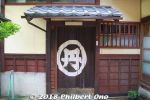
Nov 27, 2018
|
|

They are in this distinctive, traditional building rebuilt in 1930 after the big 1927 Tango earthquake.Nov 27, 2018
|
|
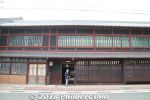
Another stop was a Tango chirimen wholesaler named Yoshimura Shouten (株式会社 吉村商店 峰山支店). Founded in 1830 and based in Kyoto city, this is their branch shop in in Mineyama, Kyotango. Nov 27, 2018
|
|
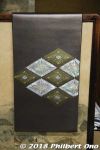
This is a replica of an obi sash that was selected and worn by Empress Michiko recently for her birthday.The company is especially proud of this, but can't publicly brag about it. (The empress does not know who made the obi. She just liked the design.)
http://tamiya-raden.jp/Nov 27, 2018
|
|
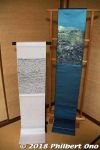
Tamiya Raden also makes kimono obi sashes.They also supply fabrics to world-famous luxury brands, but they can't brag about it because of a non-disclosure agreement.Nov 27, 2018
|
|
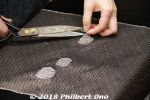
Working on an obi sash. Nov 27, 2018
|
|
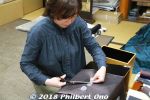
Working on an obi sash. Nov 27, 2018
|
|
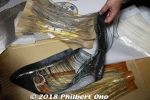
The completed design on washi paper is then sliced into "threads" that will be woven into the fabric.Nov 27, 2018
|
|
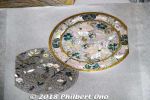
It's a painstaking, time-consuming process.Nov 27, 2018
|
|
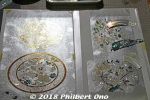
First they attach the thin shell/pearly layers on a design on washi paper.Nov 27, 2018
|
|
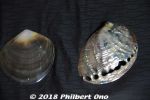
Pearly shells used in their fabrics.Nov 27, 2018
|
|
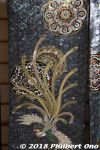
The kimono was woven with pearly shell pieces from five species of oysters. Might be hard to see which parts of the kimono are the shell inlay, but the shiny parts are not the shell pieces. Very glittery.Nov 27, 2018
|
|
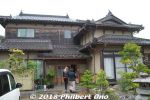
Tango chirimen silk fabric maker Tamiya Raden (民谷螺鈿).Nov 27, 2018
|
|
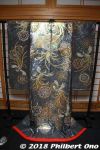
Tamiya Raden (民谷螺鈿) had this stunning silk kimono on display for us. "Raden" means inlay (using shell, ivory, etc.). Typically, we think of lacquerware, but they do it on fabrics. This kimono took 2.5 years to make and is worth more than a Lamborghini or Rolls Royce.Nov 27, 2018
|
|

Company president Tamiya Kyoji answered our many questions about this amazing kimono. His father Tamiya Katsuichiro took two years to develop and invent a method to inlay shell pieces in fabrics and showed their first example on a kimono obi sash in 1977.Nov 27, 2018
|
|
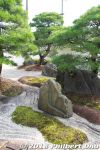
Garden of Hosenju (蓬仙寿の庭), Kyotango, Kyotohttp://www.tayuh.jp/Nov 27, 2018
|
|
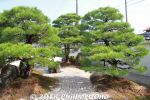
Within Tayuh Kigyo's factory grounds, there's also the Garden of Hosenju (蓬仙寿の庭) designed by Shigemori Mirei (1896–1975 重森三玲), a famous Japanese garden designer.Nov 27, 2018
|
|
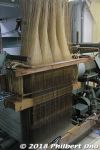
Nov 27, 2018
|
|
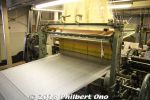
Nov 27, 2018
|
|
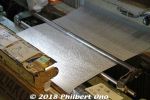
Fascinating to watch. Nov 27, 2018
|
|
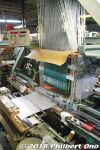
Nov 27, 2018
|
|
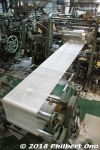
Nov 27, 2018
|
|
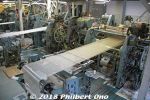
Nov 27, 2018
|
|
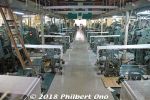
Very noisy and very fast-moving. One employee monitors several looms.Nov 27, 2018
|
|

Tayuh Kigyo's factory has 60 mechanized looms (50 of them are Jacquard looms).Nov 27, 2018
|
|
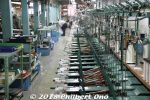
Nov 27, 2018
|
|
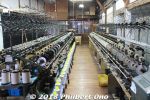
Nov 27, 2018
|
|

Nov 27, 2018
|
|
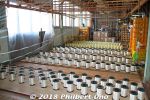
Tayuh Textile Co. makes almost everything, from the silk threads to the fabrics. We toured their impressive factory. These are spools of silk being made into threads.Nov 27, 2018
|
|
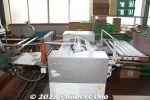
Nov 27, 2018
|
|
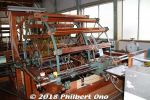
This is a thread twister to twist the horizontal silk threads (weft) 3,000 to 4,000 times. This is a key step and how chirimen gets its crimped surface. After being woven into the fabric, the highly twisted weft threads try to untwist, creating the crimping.Nov 27, 2018
|
|
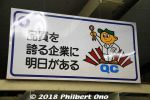
Tayuh Kigyo's company motto: "A company that boasts quality has a future."Nov 27, 2018
|
|
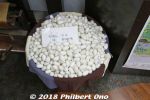
This is 3,000 silk cocoons. That's how much silk is needed to make silk fabric for one kimono. One cocoon has 1200–1500 meters of silk thread. Since Japan produces very little silk, most are imported from China and Brazil. The Tango region consumes about one-third of Japan's raw silk imports. We were told the quality of silk from China and Brazil is very good.Nov 27, 2018
|
|
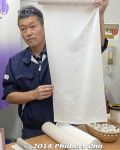
He showed us the finished product, a chirimen fabric with a woven design.Nov 27, 2018
|
|
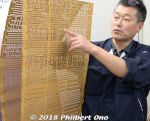
Tayuh Kigyo's third-generation company president Tamoi Hayato (田茂井 勇人) first explained about their chirimen manufacturing process.These looping punch cards called "mon-gami" (紋紙) program the Jacquard loom to weave the design on the fabric. The holes in the punch cards tell the loom which threads are to be raised or not during the weaving process. These punch cards can be made by computer now.Nov 27, 2018
|
|
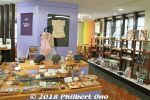
First we saw Tayuh Textile Co.'s gift shop and showroom.Nov 27, 2018
|
|
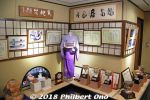
Lobby of Tayuh Textile Co.Nov 27, 2018
|
|
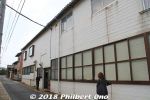
Tayuh Textile Co.'s chirimen textile factory in Kyotango.Nov 27, 2018
|
|
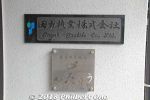
Visited a Tango chirimen company called Tayuh Textile Co., Ltd. (Tayuh Kigyo 田勇機業株式会社). http://www.tayuh.jp/Nov 27, 2018
|
|
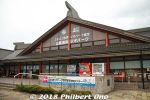
Nov 27, 2018
|
|
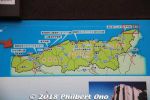
San'in Kaigan Geopark (山陰海岸ジオパーク) from Kyoto to Tottori.Nov 27, 2018
|
|
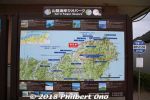
San'in Kaigan Geopark (山陰海岸ジオパーク) Nov 27, 2018
|
|

San'in Kaigan Geopark (山陰海岸ジオパーク) area.Nov 27, 2018
|
|
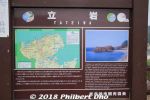
Nov 27, 2018
|
|
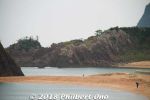
Nov 27, 2018
|
|

Tateiwa RockNov 27, 2018
|
|
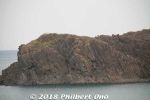
Tateiwa RockNov 27, 2018
|
|

How Tateiwa Rock formed. This large mass of volcanic rock formed when the magma erupted and accumulated within the earthen strata below the surface. The magma didn't break the surface. However, the surrounding strata was soft and eventually eroded to expose only this hard volcanic rock called Tateiwa (Standing Rock).Nov 27, 2018
|
|
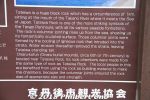
About Tateiwa Rock.Nov 27, 2018
|
|
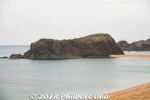
Tateiwa Rock on Tango Peninsula.Map (Tateiwa): https://goo.gl/maps/QDHmG1qArezNov 27, 2018
|
|
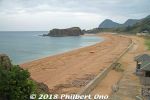
Tateiwa Rock on the Tango Peninsula, northern Kyoto. The swimming beach leading to Tateiwa is named Tateiwa Nochigahama (立岩後ヶ浜海水浴場).Nov 27, 2018
|
|
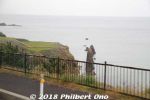
Byobu Iwa rock.Nov 27, 2018
|
|
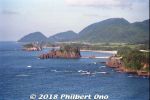
Tango Matsushima (pine islands).Nov 27, 2018
|
|

Tango Matsushima (pine islands).Nov 27, 2018
|
|

Tango Peninsula coast.Nov 27, 2018
|
|

These photos were taken while cycling along the Tango Peninsula.Nov 27, 2018
|
|

Tango Peninsula in northern Kyoto Prefecture is scenic along the coast with a number of natural features and formations.Much of the coast is part of the San'in Kaigan Geopark (山陰海岸ジオパーク) that extends from the western half (Kyotango city) of Tango Peninsula to Tottori Prefecture. San'in Kaigan Geopark is also a UNESCO Global Geopark. Nov 27, 2018
|
|
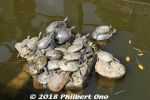
Turtle pond.http://www.konpirasan.com/Nov 27, 2018
|
|

Sorehouse for the shrine's festival float and mikoshi portable shrine.Nov 27, 2018
|
|
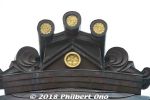
Nov 27, 2018
|
|
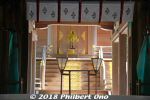
Inside Haiden prayer hall.Nov 27, 2018
|
|
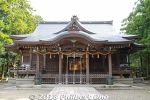
Kotohra Shrine's Haiden prayer hall.Nov 27, 2018
|
|
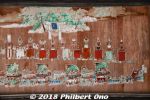
Sadly, most all of the 30 ornate festival floats were lost in the 1927 earthquake. Only this painting of the floats remains. Small little town like this to have this many ornate floats was very unusual. Thanks to the chirimen merchants. Such glory days are long gone though, as chirimen sales peaked long ago.
Nov 27, 2018
|
|
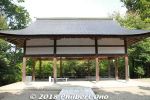
Kotohira Shrine's Ema Hall (絵馬舎) used for prayers for safe seafaring. This hall had a large painting of the shrine’s grand float festival held about 100 years ago.Nov 27, 2018
|
|
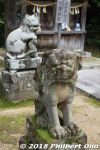
Koma-inu lion dog also protects the shrine.Nov 27, 2018
|
|
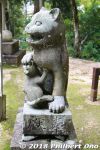
The left koma-neko cat is the mother (holding a kitten).Nov 27, 2018
|
|
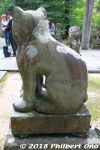
Nov 27, 2018
|
|
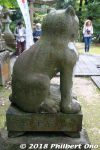
Back view of Koma-neko.Nov 27, 2018
|
|
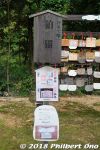
"Koma-neko Unique in Japan"Nov 27, 2018
|
|
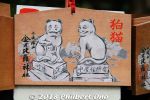
Koma-neko ema prayer tablet.Nov 27, 2018
|
|

Kishima Shrine has koma-neko cat guardians because silk farmers in the 19th century kept cats to protect their precious silkworms and cocoons from rats. Rats were a major problem for the silk industry.They ate the silk cocoons and worms. So cats saved the local silk industry.
The left cat is the mother (holding a kitten), and right cat is the father. Also respectively "A" and "un."
These koma-neko cat guardian statues were donated in 1832 by silk merchants and wholesalers such as the Tonomura family (外村家一族、岩滝のちりめん問屋、山家屋の小室利七) who were textile merchants from Higashi-Omi (Gokasho), Shiga Prefecture.狛猫Nov 27, 2018
|
|

Kotohira Shrine has this unique affiliate shrine named "Kishima Shrine" (木島神社) which is the left half of this building. (The right-half shrine is Sarutahiko Shrine [猿田彦神社] for the god of transportation and directions.)Kishima Shrine is unique in Japan for these two koma-neko cat guardians. Shrines usually have koma-inu lion-dog guardians (to ward off evil spirits), but only this shrine in all of Japan has cat guardians instead.Nov 27, 2018
|
|
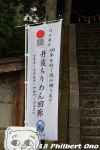
Japan Heritage banner marking the 300th anniversary of Tango chirimen.Nov 27, 2018
|
|

Kotohira Shrine's head priest Wakisaka Takuji (宮司 脇坂卓爾) explained it to us.Nov 27, 2018
|
|
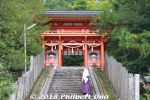
Nov 27, 2018
|
|
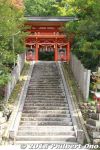
This shrine in Mineyama, Kyotango greatly benefited from the patronage of rich, local Tango chirimen makers and it is unique for its koma-neko cat guardians.Nov 27, 2018
|
|
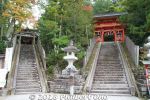
Established in 1811, Kotohira Jinja Shrine (nicknamed Konpira-san 金刀比羅神社) in Kyotango, Kyoto mainly worships Konpira (aka Kompira), the god who protects sailors, fishermen, ocean transport, navy personnel, and other seafaring people. People also pray here for business prosperity, family safety, scholastic excellence, safe childbirth, recovery from illness, and more. There are at least 30 Kotohira/Konpira Shinto shrines in Japan and the headquarters shrine is Kotohira-gu Shrine in Kotohira, Kagawa Prefecture in Shikoku.
Nov 27, 2018
|
|
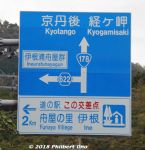
Spelled "Village" wrong...Nov 27, 2018
|
|
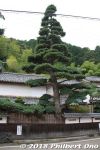
Mukai Shuzo's big Japanese evergreen tree outside, 300 years old.Nov 27, 2018
|
|
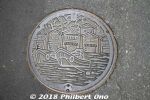
Ine manhole in Ine, Kyoto.Nov 27, 2018
|
|
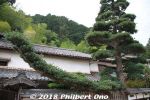
Mukai Shuzo's big Japanese evergreen tree outside, 300 years old.Ine, Kyoto PrefectureNov 27, 2018
|
|
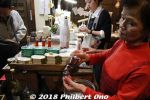
Stopped by Mukai Shuzo Sake Brewery's gift shop to taste some sake and other drinks. Nov 27, 2018
|
|
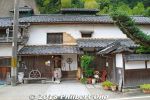
Mukai Shuzo Sake Brewery's gift shop.Nov 27, 2018
|
|
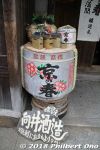
Their main sake brand is called "Kyo-no-Haru" (京の春).Nov 27, 2018
|
|
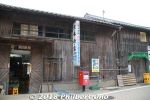
Mukai Shuzo Sake Brewery's chief brewer is Mukai Kuniko (向井 久仁子) born in 1975 in Ine. She graduated from an agricultural college in Tokyo and took over from her dad. Her younger brother is the president of the company. http://kuramoto-mukai.jp/Nov 27, 2018
|
|
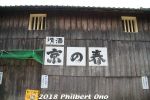
Ine also had a sake brewery called Mukai Shuzo Sake Brewery (向井酒造株式会社).Nov 27, 2018
|
|

About Ine and funaya.Nov 27, 2018
|
|

Funaya Shokudo restaurant menu.Nov 27, 2018
|
|
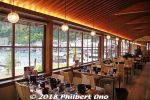
Funaya Shokudo restaurant. http://www.ine-kankou.jp/taste/funayashokudo/Nov 27, 2018
|
|
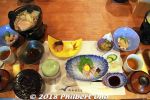
We had the Funaya Teishoku for lunch mostly seafood, worth ¥2,000.Nov 27, 2018
|
|

Across from Ineura Park is the new Ine Tourist Information Center on the 1st floor and a restaurant (Funaya Shokudo 舟屋食堂) on the second floor where we had lunch.Nov 27, 2018
|
|
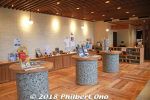
Ine Tourist Information Center on the 1st floor.Nov 27, 2018
|
|

Small waterfront Ineura Park (伊根浦公園) on Ine Bay.Nov 27, 2018
|
|
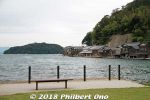
Ineura Park (伊根浦公園) on Ine Bay.Nov 27, 2018
|
|
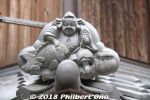
Roof tile ornament of Ebisu, god of fishing.Nov 27, 2018
|
|
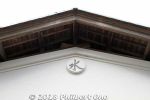
Nov 27, 2018
|
|
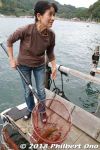
Mrs. Yamada also keeps fish in a net under their small dock. I asked what kind of fish, and she caught two to show us.Nov 27, 2018
|
|

They were Redspotted Grouper (アコウ、キジハタ), a valuable fish delicious as sashimi. They are feeding these fish until they get big enough for eating.Nov 27, 2018
|
|
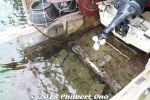
I asked about the recent typhoons that hit this area. Mrs. Yamada said that the secured boat shook a lot, but no damage.Nov 27, 2018
|
|
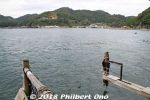
Looking out from the boat garage. Nov 27, 2018
|
|
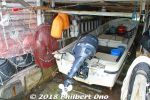
The boat was also hoisted to dry in the garage. Since seawater tended to rot wood, drying the boat when not in use would make the boat last longer.Nov 27, 2018
|
|
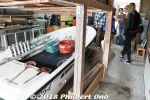
These boat garages were originally built to protect the boat from the elements. In the old days, boats were made of wood. They did not have a waterproof deck like modern boats do today. So the boat garage protected the boat from rain, etc.Nov 27, 2018
|
|
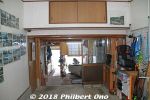
Enter the car garage and walk toward the back to see another room.Nov 27, 2018
|
|
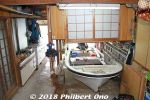
In the back of the car garage is the boat garage on the water's edge. The small fishing boat is hoisted and secured by a power winch. Above the boat is just storage space (not another room). The family uses the boat to catch fish for themselves.Nov 27, 2018
|
|
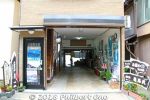
This is the boathouse of Mr. and Mrs. Toshikazu Yamada (山田 敏和), a very friendly fishermen couple who runs Ine boat cruises and work as fishermen.This is what a funaya boat house looks like from the road. First there is a normal car garage. The boat house is not that big. Nov 27, 2018
|
|
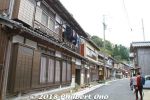
We also had a guided walking tour of Ine village. Behind the funaya boat houses is this narrow coastal road and another row of homes across the road on the left at the foot of the hills. The homes along the left are the main homes where the fishermen's family live. And their funaya boat houses are right across the road on the right. Nov 27, 2018
|
|
| 71466 files on 284 page(s) |
 |
 |
43 |  |
 |
|